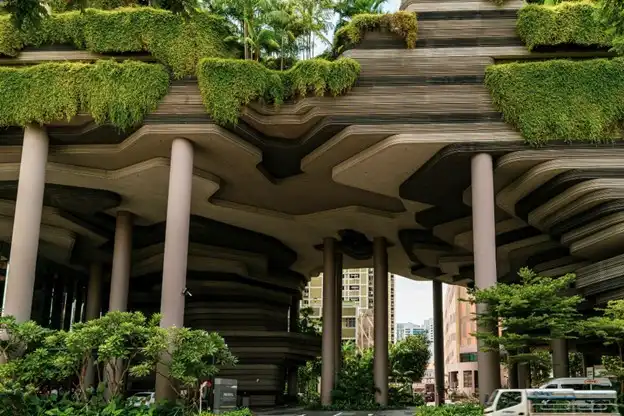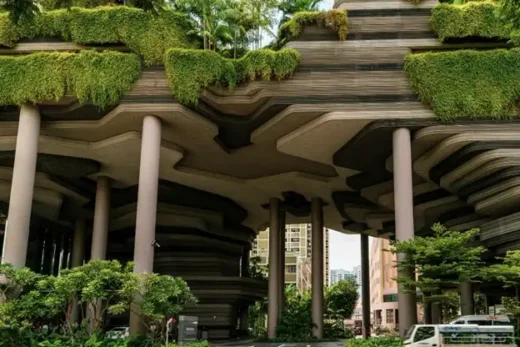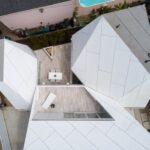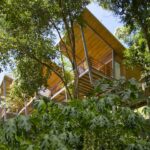Merging architecture with nature in biophilic design, Green architectural designs
Merging Architecture with Nature in Biophilic Design – Is it Safe?
7 March 2025
How can architecture transform our daily experiences? Imagine entering a building that feels like a serene forest. Biophilic design, which integrates natural elements into architecture, is reshaping our spaces. A recent study in the Living Architecture Monitor revealed that incorporating nature into environments can enhance physiological and psychological well-being.
This design trend not only beautifies our surroundings but also improves our overall health and efficiency. As urban areas continue to expand, the demand for nature-inspired spaces grows stronger. Biophilic design addresses this need by creating harmonious environments that nurture both the mind and body.
Let’s explore how the fusion of architecture and nature is transforming our built environment.
Why Nature Matters in Architecture
Exposure to natural elements such as plants, sunlight, and fresh air has a significant impact on our health. Research indicates that this exposure can alleviate stress, decrease blood pressure, and enhance mood.
For instance, a study by Dr. Oliver Baumann at Bond University found that curved spaces with natural views experienced increased happiness and creativity. Individuals living in such spaces also showed reduced stress levels and lower heart rates.
Architects leverage these advantages by integrating biophilic concepts into their design practices. They create environments that replicate natural settings, fostering relaxation and well-being.
As recently reported in Architecture Digest, a notable example is the Populus Hotel in Denver, designed by Jeanne Gang. This hotel takes cues from Colorado’s Aspen trees and includes features that establish a connection to nature.
Key Characteristics of Biophilic Design in Contemporary Architecture
Incorporating biophilic architecture can beautify buildings while supporting the health and well-being of the people who inhabit them.
- Green roofs and living walls: These elements not only improve air quality but also contribute visual appeal to buildings. They act as natural insulation, leading to decreased energy use.
- Natural light optimization: Increasing natural light reduces reliance on artificial lighting, conserving energy. It also aligns with our body’s circadian rhythms, enhancing sleep quality and overall health.
- Water features: Indoor fountains and ponds establish soothing environments. The sound of flowing water can help lower stress and boost concentration.
- Organic materials: Utilizing materials such as wood and stone brings warmth and texture to spaces, fostering a connection to the natural world.
- Indoor gardens and courtyards: Incorporating plants inside boosts air quality and offers visual interest. These green spaces provide scope for socializing and relaxation.
Biophilic Design and Safety Considerations
The Jack C. Taylor Visitor Center at the Missouri Botanical Garden in St. Louis exemplifies biophilic design. ArchDaily notes that it seamlessly integrates natural elements into its architecture. Features like custom terrazzo flooring with river rock inlays and woodland-inspired brass accents create a harmonious connection.
Design elements at the Jack C. Taylor Visitor Center enhance aesthetic appeal and promote well-being. However, they can also pose safety risks. For example, natural materials like limestone in flooring may increase slip-and-fall incidents, particularly in moist areas. Similarly, water features and indoor gardens require careful maintenance to avoid hazards such as wet surfaces or overgrown plants.
In St. Louis, slip-and-fall accidents in public spaces have resulted in several personal injury lawsuits. Victims are seeking compensation for their injuries. A St. Louis personal injury attorney can assist those harmed due to unsafe conditions in aesthetically focused buildings.
To mitigate these risks, it’s essential to choose slip-resistant materials, implement proper drainage, and maintain regular protocols. This way, architects and facility managers can enhance visitor experience while ensuring safety.
Safety Challenges in Biophilic Architecture
Biophilic architecture incorporates natural elements into building design, enhancing well-being and sustainability, but it comes with challenges.
Structural Considerations
Green roofs and living walls improve urban biodiversity but may present structural issues if not properly designed. In Basel, Switzerland, reported the Guardian, green roofs are required for new and renovated buildings. This emphasizes the need for solid structural assessments to prevent potential damage.
Slip and Fall Hazards
Water features and wet surfaces can increase slip-and-fall risks. Slip and fall accidents in such public spaces can lead to personal injury lawsuits, according to TorHoerman Law. The possibility of its occurrence becomes high when property owners fail to address known hazards.
Victims of such accidents often seek legal assistance to recover medical costs and lost wages. Regular maintenance and slip-resistant materials are essential to reduce these risks.
Allergen Exposure
Introducing plants indoors can improve air quality but may also expose occupants to allergens. Pollen and mold from indoor vegetation can affect individuals with allergies or respiratory conditions.
Balancing natural elements while maintaining indoor air quality is crucial. Careful selection of plant species and proper ventilation can minimize allergen exposure, advises a paper published in the Journal of Building Engineering.
The Future of Biophilic Architecture
Biophilic design is set to play a larger role in urban planning and construction. Cities are increasingly integrating green spaces, rooftop gardens, and living walls into new developments, notes Urban Design Lab. As this trend grows, innovations in materials and safety technology will help reduce risks.
Future designs will also focus on balancing aesthetics, functionality, and occupant safety. Architects are exploring smart ventilation systems and allergy-friendly plants to improve indoor air quality without compromising health. By prioritizing both beauty and safety, biophilic architecture will continue to shape sustainable and livable urban spaces for future generations.
FAQs
Can biophilic design increase slip and fall risks?
Yes, water features and plant overgrowth can create slippery surfaces. Living walls or greenery on floors can obstruct walkways or cause tripping hazards. Improper maintenance, such as not cleaning up fallen leaves or water pooling around plant installations, can further increase these risks.
What legal risks exist in biophilic architecture?
Property owners may face personal injury lawsuits if hazards like wet floors or poor maintenance lead to accidents. Proper safety measures help reduce liability. Zoning and land use regulations can also restrict the use of certain natural elements or construction techniques.
What safety measures can be taken to avoid risks in biophilic spaces?
Address both environmental and physical hazards. First, materials used in these spaces should be non-toxic, sustainable, and fire-resistant. Regular inspections of elements (plants, or water features) are necessary to prevent overgrowth, water stagnation, or pests that can pose health risks.
Biophilic architecture is shaping the future of sustainable, wellness-focused spaces—but safety must evolve with it. By blending nature with smart design, we can create buildings that are beautiful and secure for everyone.
Comments on this guide to Merging architecture with nature in biophilic design article are welcome.
Sustainable Building Design
Key Sustainable Design Articles
New vaulted style of floor cuts concrete usage
Ground granulated blast furnace slag in concrete production
Concrete – Delivering beyond net Zero
Biophilic Buildings
Biophilic Building Designs
Primary school of the future: biophilic building
Biophilic design at Heriot Watt campus Dubai
Milan biophilic office of the future
MITOSIS Biophilic Regenerative Ecosystem
Biophilic Office Project at BRE, Watford
+++
Resilient Cities Architecture Design
Property Design
Contemporary Property Designs – recent architectural selection from e-architect below:
Comments / photos for the Merging architecture with nature in biophilic design page welcome.






